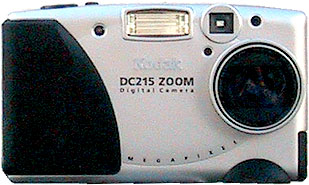
Sensor Size: CCD unknown
Max Resolution: 1152x864
Approx. dates of manufacture: 1999
Memory card: Compact Flash (CF)
Approx. street value: low
Toward the end of the 20th century, Kodak was really stumbling along as a camera maker. They'd been forced out of the upper-end of the market by the European and Japanese makers. The low-end market eroded as their 126 and 110 formats had run out of steam and the Japanese began making quality 35mm "point-n-shoot" cameras that were both inexpensive and reasonably high quality. Kodak's disc cameras fizzled, and they lost an important patent-infringement suit by Poloroid which knocked Kodak completely out of the instant-picture market. They completely missed the videotape and camcorder era, which destroyed the 8mm/Super-8 amateur film market almost overnight. In the 80s and 90s they managed to stay in the consumer market with disposable cameras, which may have been profitable but had no prestige. Kodak's name as a camera maker was primarily associated with cheap junk.
But in the late 90s, Kodak weighed in heavily with digital cameras. Its name appeared on high-end SLRs due to partnerships with Japanese camera makers, and it began taking back its old bread-and-butter niche, the low-end, point-n-shoot mass-market.
Kodak pretty much abandoned its Brownie name (for reasons I don't understand) but the tradition lives on with its cameras. This Kodak DCS 215 was a Christmas gift to me; my first digital camera. On paper it's great: it has an optical zoom, an LCD back, on-board flash, it takes a standard CompactFlash card, and best of all, it runs off four AA batteries that you can buy anywhere (as opposed to my Canon S100, which requires an expensive, odd-ball rechargable). It's small, light, well balanced and easy to use.
My main complaint with it is that the image quality was softer than I was used to. But what really got to me was that there was some kind of electronic failure that required me to send it in to service. Of course it was out of warranty, and I had to pay a chunk to get it fixed. I think I'd taken maybe 3-dozen photos with it, so I was very unhappy about that. I never used it again.
Camera manual: Orphan Cameras.com


